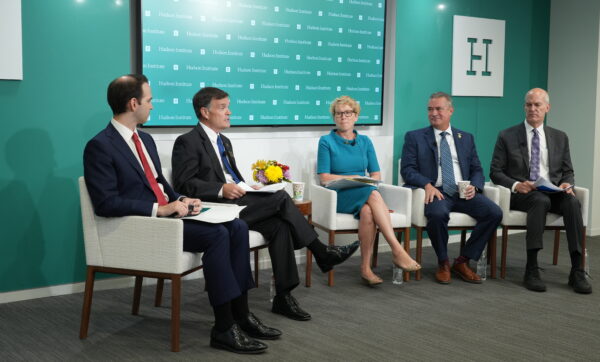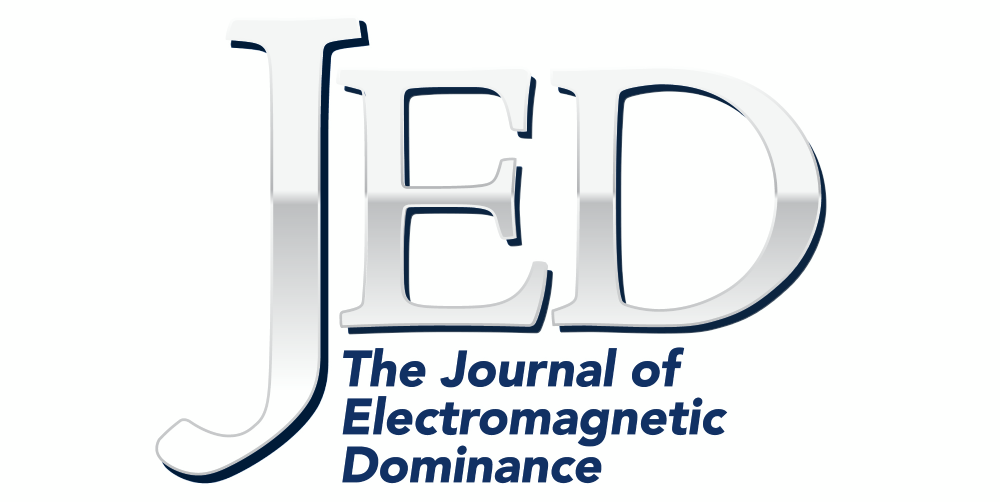
By John Knowles
On July 18, the Hudson Institute and AOC hosted three co-chairs from the Congressional Electromagnetic Warfare Working Group (EWWG) for a panel discussion about some of the leading Electromagnetic Spectrum Operations (EMSO) issues facing the DOD. Rep. Don Bacon (NE-02), Rep. Chrissy Houlihan (PA-06) and Rep. Rick Larsen (WA-02) took questions from AOC President Brian Hinkley and Hudson Senior Fellow Timothy Walton, as well as audience members, on a variety of EMSO-related topics, including the DOD’s EW priorities; spectrum sharing between DOD and commercial EMS users; the new Joint EMSO Center (JEC) at US Strategic Command; EMSO training and range modernization; EMSO cooperation with international partners; and EMSO lessons being learned in the Russo-Ukrainian war. Here are some of the highlights from this informative discussion:
DOD EW Priorities: One topic that dominated the discussion was the way DOD has prioritized EW. In general, the panelists thought the DOD has not done enough to focus on EW matters. Congressman Bacon, who was an Air Force Electronic Warfare Officer and led both the 55th Electronic Combat Group at Davis-Monthan AFB, AZ, and the 55th Wing at Offutt AFB, NE, provided some background for perspective. He said, “When I came in [into the Air Force]in 1985, I thought the US Electronic Warfare capabilities were second to none. We were the preeminent EW military in the world. We had the ‘iron on the ramp’ with what we called the electronic warfare triad. We had the EA-6s, the Compass Call, Rivet Joint, the F-4Gs, and we had a great strategy. We had a great personnel development system with the electronic warfare school. We had a two-star in charge [of EW], at least in the Air Force. You had a lot more oversight in the Joint Staff. But after 1991, when we just kicked the living ‘bejeebers’ out of Iraq, we felt like we didn’t need EW as much anymore. So we just put it on autopilot in the 1990s, and over time it just sort of withered and atrophied. Even in the ’90s, I felt like we had the preeminent EW [capability]. By the time I was a colonel and brigadier general [in the 2000s and 2010s], it was clear that we let things atrophy to a large degree and Russia and China in many areas had surpassed us because they were focused on it.”
The EWWG has been working on multiple issues to reverse this EW atrophy at DOD, especially by including clear EW policy direction, also in coordination with the Senate Armed Services Committee (SASC) in the annual National Defense Authorization Act legislation over the past several years. Bacon explained, “When I got elected in 2017 – I was working with Congressman Larsen initially – we’ve been able to put a lot of good things in the legislation. We’ve been able to mandate that the DOD or Joint Staff put people in charge that we can hold accountable, a new strategy, a new implementation plan, insist that each COCOM have an [EMSO] cell…”
Larsen also provided an interesting historical perspective based on his long tenure co-chairing the EWWG. He told the audience, “And if I could maybe offer a quick 22-year perspective, [it]is that funding for EW or EMSO is feast or famine. It’s ‘feast’ when we need it, and we always need it too late because we’re always in a famine mode, when we don’t think we need any more. And the truth is we know we always need it.”
Larsen also said another major lesson is that EW needs more than simply funding EW programs. He added, “…the second lesson is you need leadership at the Pentagon, you need a training aspect to make sure there’s always people coming into the pipeline, you need to partner with the research labs, and you need the industry. “Those are always the four key elements, and I only know this because we wrote this report, I think, in 2003,” he added sarcastically. “So, the framework is always there. We just need to fill it, and the Pentagon needs to fill that framework, too.”
Houlihan added another perspective. She said, “The last part of the puzzle is, I think, education. And education not just of people who know all the things and who’ve been doing it for a long time and education of the HASC and of the Intel Committee. … But also just education of the common member of Congress in terms of why it is that we’re talking about these issues and why we care about them and why we need to fund them. … And so I think that that’s another aspect of trying to make sure that we can educate the public and educate the people who are making the votes on why these things are important.”
Bacon followed up by providing a clear sense of why the EWWG, and Congress in general, has been important to advancing EW policy. “If it wasn’t for Congress,” he said, “any progress we made in the last six or seven years I don’t think would have happened. The military was not interested, generally, in putting someone in charge, new strategy, funding lines. It was us [Congress] mandating it in the NDAA. A lot of times the military doesn’t want Congressional interference. I think in this case we did some good.”
Asked by a reporter what the DOD can do to accelerate acquiring new EW capabilities, Bacon responded, “We’re going to have to keep pushing until they [the Services]start leading. Unfortunately, that’s how I perceive it. [As] and example, one of the Services…gave us a brief saying, ‘This is the capability we need to counter our threats in Asia.’ I asked, ‘How much are you budgeting for it?’ [Their response] was ‘zero.’ There’s a disconnect there. Until they can come in and say, ‘This is our need, and here’s out plan to get there, and here’s how we’re spending the money,’ it’s just all talk. And so I feel compelled that we have to keep pushing [the DOD]until they’re leading on this. And I just haven’t seen it yet. And I get it, too,” he added. “There’s a finite budget….Everyone’s got all these needs that it makes it hard to fit it all into one budget. I understand that. But what they’re really saying is, ‘Okay, we need this capability, but we’re not going to spend [the money for it.]’ They’re pretty much asking us to find a way to do it for them. That’s my take.”
Spectrum Sharing: Both the HASC and SASC have been very concerned about the proposal to permit commercial access to spectrum (3.1- to 3.45-GHz), which is currently used exclusively by the DOD. In the past, the DOD has been binary about spectrum access, either rejecting commercial use of spectrum it depends on or vacating that spectrum for commercial use. The concept of spectrum sharing, although widely practiced on the commercial side, is a relatively new concept that DOD is considering. The EWWG leadership has been meeting with DOD officials to help guide Congress on the current proposal to permit commercial access to this S-Band spectrum for 5G applications, some of which the DOD will be able to use. Bacon told the audience, “Our S-Band … is very important to our radar missions that are out there [including air defense and national missile defense], and you don’t want to degrade that. 5G is very critical to our economy. So they’re both very important and I think that if we can find a technical solution, that’s obviously the optimal [solution]. … But we have to prove that it’s going to work, because we need 5G and we have to have the important radar missions that the DOD operates. But if we can’t prove it, [DOD] can’t just vacate the radar missions that are already out there. So they’re going to have to prove that this 5G can operate in that space.”
International Cooperation: Bacon drew on his experience as commander of the 55th Wing to make a point about the need for greater international cooperation in EMSO. In his example, he described how the US and the UK found a way to boost cooperation in the sensitive area of airborne tactical signals intelligence (SIGINT). The opportunity arose in the 2010 timeframe, when the UK retired its three Nimrod R.1 SIGINT aircraft and chose to replace them with three RC-135V/W Rivet Joint aircraft identical to the 17 RC-135V/Ws flown by the US Air Force. He explained, “The British bought three RC-135s, and we had 17 in the Air Force … So that’s fleet of 20. I had to oversee the training. We brought the British into Offutt. We’re training [UK] guys that have 4,000 hours in the Nimrod [R.1 SIGINT aircraft]. They were teaching us a lot of things. The British have – they pretty much invented electronic warfare frankly. And so to have that synergy between us – they were learning to fly the RC, but they were teaching us a lot on the science of EW. They go to one weapons system, frequently. That’s where they [sometimes will]stay for 30 years. We do our three-year assignments. So, it’s just this different culture, and we really benefitted from this mutual training.”
“But my vision was … let’s not treat this as 17 and three.” Bacon said he did not want the US RC-135 fleet to cover its operational assignments and then the RAF to duplicate some of those assignments, when the US and UK could approach this as a team that had a fleet of 20 RC-135s. It was unprecedented and it posed bureaucratic, security and information access challenges. “That means you have to have a common database – everything had to go into a common database.” He said his combined plan failed while he was active duty, but it became a reality after he retired from the Air Force. “Now they treat it like a fleet of 20. I’ll tell you that’s a win-win for Britain and America. … To be able to do that, you had to be able to put British on US airplanes and Americans on British airplanes. We’re doing that, now. I think it’s the benchmark of how allies can work together in the EW area. But it didn’t come easy,” he added. He went on to say, “I suggest, why can’t we take the US-British model and see how we can expand that type of cooperation]. I think Australia is a common sense next step, then maybe Japan. … Without Japan fully in with us, I don’t see how we counter China.”
Larsen, citing the example of the Royal Australian Air Force’s two EA-18G squadrons, said it’s a great idea, but the DOD is still limiting itself to a platform-by-platform approach to this type of cooperation. “This is still walking, and there’s no running at all. There’s no big idea, no big plan, as opposed to just platform-by-platform. That’s not going to cut it.”
These and other EW-related issues are addressed in the provisions of the House and Senate versions of the NDAA that is working its way through Congress. The EWWG panel session will be aired on an upcoming From the Crows’ Nest podcast. It is also available on the “events” page of the Hudson Institute (www.hudson.org). To view video, photos or hear audio from the session, please click the links below.
The EWWG panel session will be aired on an upcoming From the Crows’ Nest podcast.
YouTube Link: (2) Achieving Spectrum Superiority with the Congressional Electromagnetic Warfare Working Group – YouTube



